
5 Pillars Of A Successful Agency-Client Communication
When I started my first agency, I remember asking myself: What is
the top thing I should focus on to grow my business?
Of course it was
revenue.
But to get revenue I would also need happy customers and a happy team.
The key to
this?
Great communication.
If you run an agency or a productized service,
communication is central to the success of your business.
This guide will serve as a basis to make sure you
can constantly ensure great communication with the customers of your agency and lead to happier clients, a happier
team, and more revenue as a result.
Why is client communication important for your agency?
Client communication matters for two key reasons:
1. Better client expectations
2. A happier team and a
saner business
Better expectations = happier customers.
When I first started my agency I promised too much.
This was by far the biggest mistake I
made.
If your customers have good expectations from the start (what deliverables
they can expect to receive and how often you will communicate with them), this will set a good foundation of
success for the relationship between you and your customers.
Happier team = a saner business.
Secondly, good client communication also makes your team happy.
If client communication boundaries are set
correctly, your team will know when to send deliverables, how often to communicate internally and with your clients,
which will lead to a saner business, and more enjoyable business to run as a whole.
Sounds like music to your
ears?
Let’s now dive in to see how to ensure good client communication!
#1 Set expectations
The first step to ensure good client communication is to set expectations with your
customers.
For example:
- What your service does / doesn’t do
- Who your service is for
- How often you will communicate with clients
- When your clients can expect to receive deliverables
- What you expect from your clients
Here are a few tips to set expectations successfully:
1. Create a Work scope
page.
55Knots, a graphic design subscription
service in Australia created a “Work scope” page.
When customers arrive on that page, they see what is
included / what is not in the subscriptions offered by 55 Knots.
Why does this matter?
Customers know
exactly what to expect upfront, before purchasing a subscription.
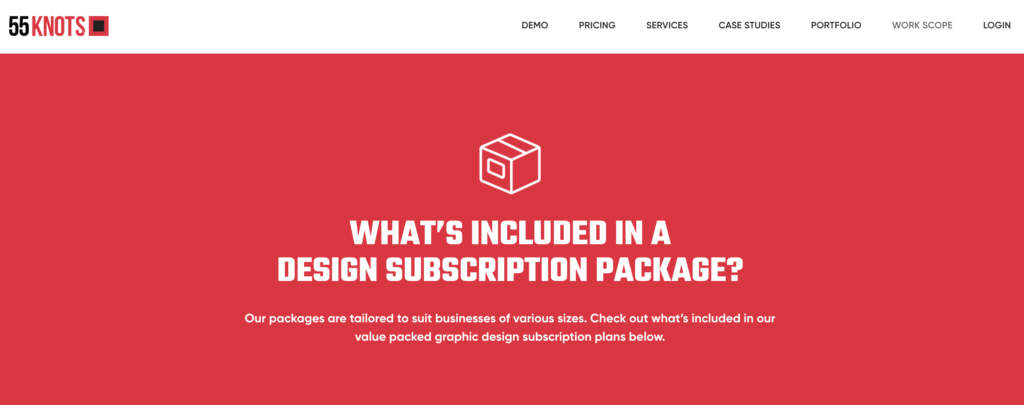
Pro tip: You can also add a “What we don’t do” section.
2. Create a
FAQ
Another tip is to create a FAQ.
This will help prospective clients qualify or
disqualify themselves depending on whether your service is a good fit for them as well as reduce your customer
support volume.
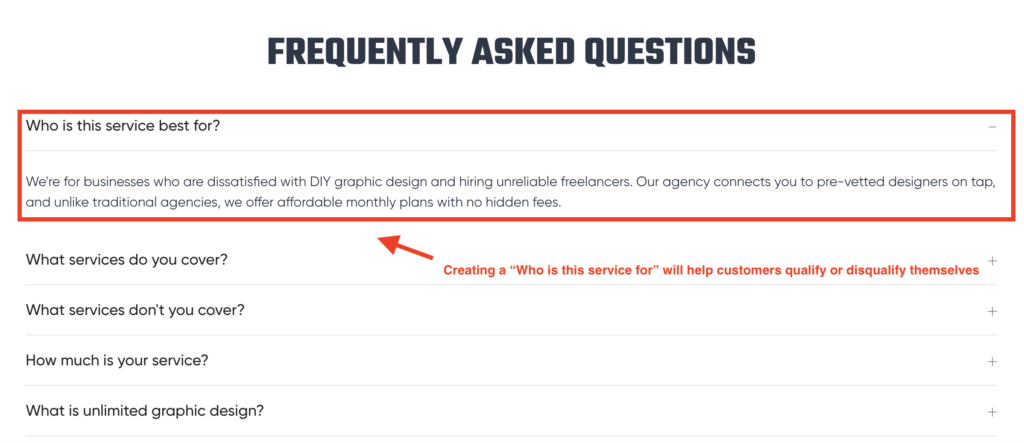
3. Create a “How it works” section
Finally, another part you can add to your website is a “How it works” section.
Here’s an example:
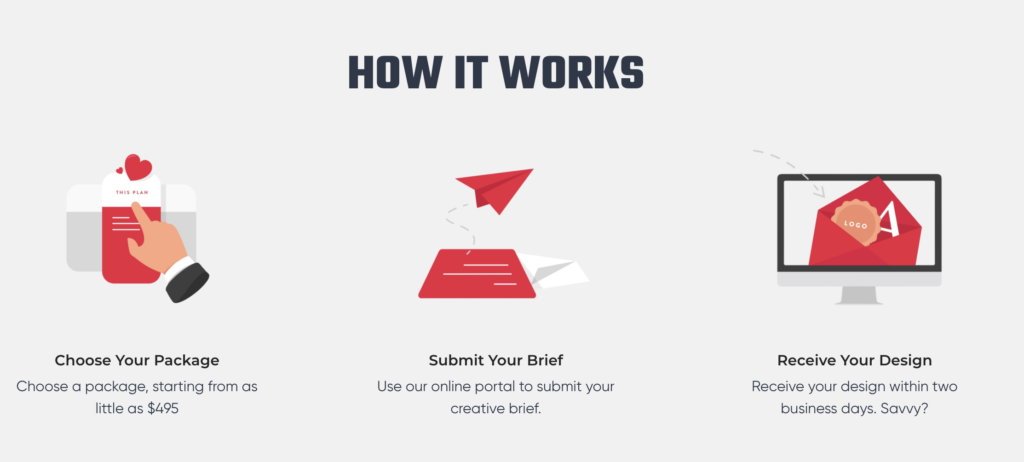
Explaining to your clients how your service is delivered, from intake, to revisions, to final delivery is a great way
to help clients understand how your service will work for them.
Pro tip: You can add expected
timelines for each step.
#2 Onboarding
Next step to proper communication: Creating a great onboarding experience for your clients.
Here are a few
things your client onboarding can cover:
- Answering any questions your customers may still have as regard to your service
- Showing how to submit requests
- Explaining what happens when they need to give feedback / if something goes wrong
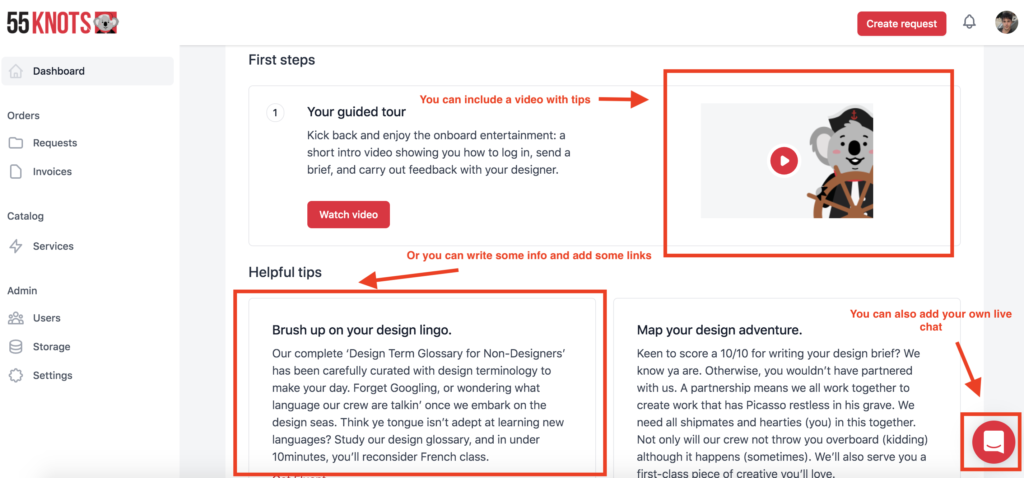
Here are a few tips to create a great onboarding experience:
1. Create an onboarding page in
ManyRequests
One thing you can do to onboard your customers successfully is create a custom
onboarding page.
In that page you can include information such as :
- Tips to create your request or
communicate with your agency
- Links to your knowledge base or case studies
- A video demo
Our
software, ManyRequests (a client portal for agencies and productized
services) allows you to create an onboarding page.
Here’s an example from 55Knots:
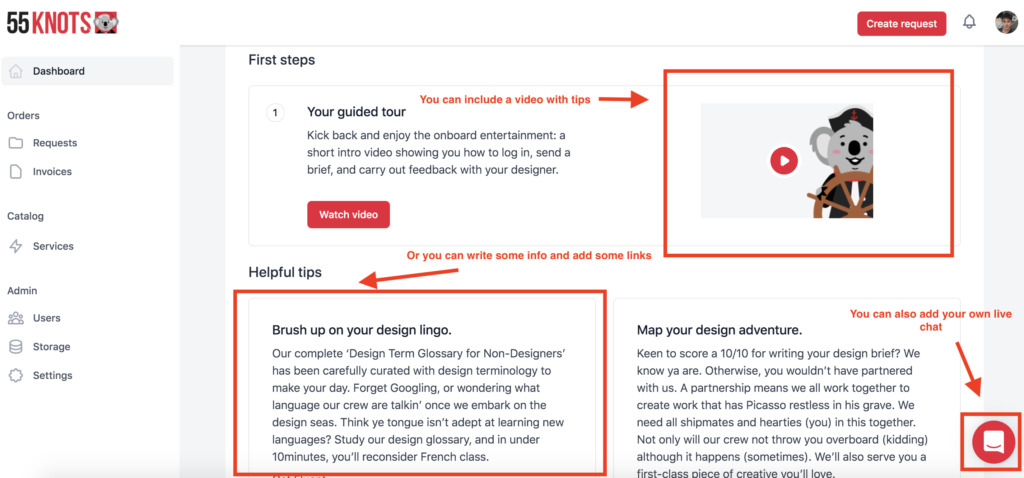
2. Send a Welcome email
Another way to onboard your customers is to create a welcome
email.
Here’s an example from Hatchly:
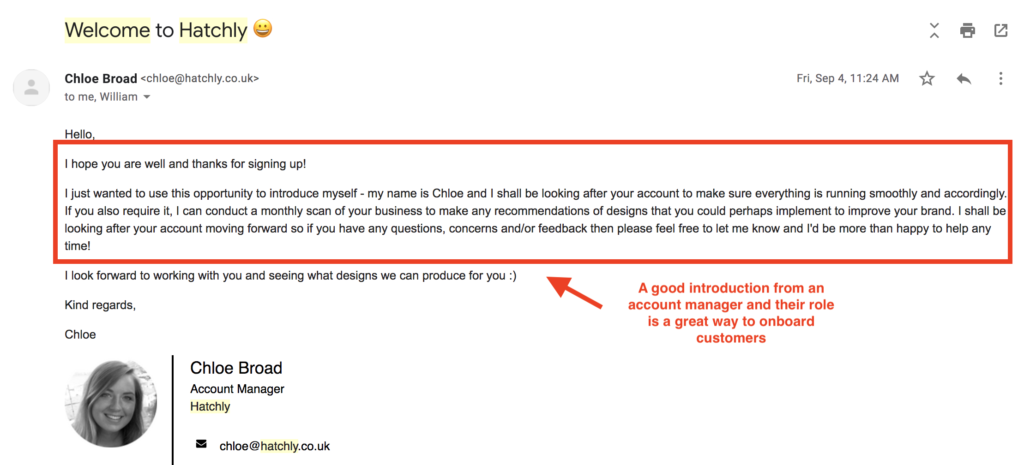
3. Create a demo video of your client portal on your website
Lastly, creating a page
with a demo video of your client portal is another great way to onboard customers.
Here’s an example again
from 55Knots:
#3 Create a client communication plan
The next step in ensuring stellar client communication is to come up with a plan for all communication required at
each step of the customer journey and service delivery.
For example:
- What happens when a request is submitted (Does your team acknowledge the request?)
- What happens if a brief is unclear? (Does your team ask questions?)
- What happens if there is a delay?
Here are a few tips to set up a successful client communication plan:
1. Acknowledge the
request
Again from 55Knots, as soon as you submit a request, their project manager gives you a
welcome and sets the ETA of the request
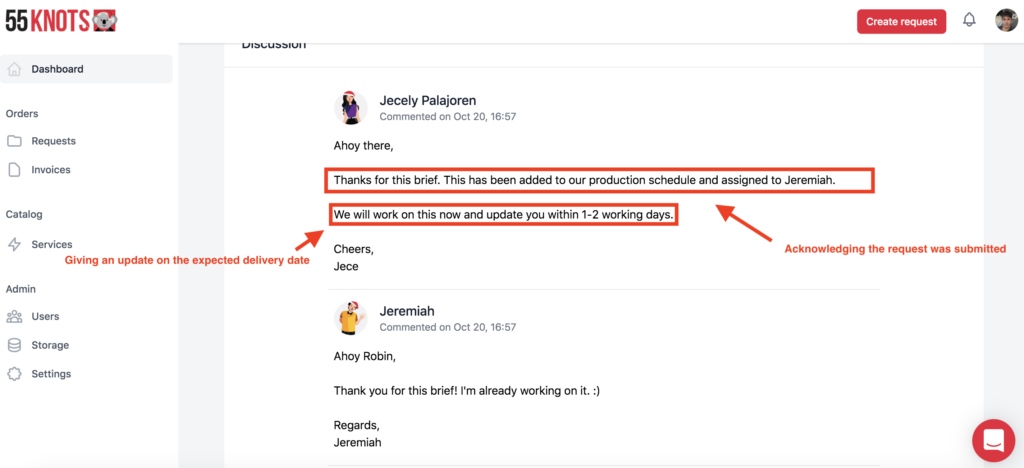
Pro tip: You can auto-assign requests to a specific team member or account manager in ManyRequests,
saving you time from assigning requests manually
2. Be proactive
Don’t
hesitate to ask questions to your clients.
For example, if the client submits a brief but there is a file
missing, an incoherence, or some information is unclear to you or your team: Tell the client as soon as
possible.
This ensures problems are solved before they become huge issues.
3. Be
transparent
Clients hate surprises.
Sometimes projects don’t go as expected: It simply
takes longer to complete, or a team member is sick and can only do it the next day.
That happens. A service
business is human after all.
That’s not the end of the world: Tell your clients about it.
Being
transparent at all times will foster trust and ensure a good relationship between your client and your
agency.
#4 Internal communication
Another important aspect of good client communication is to ensure communication within your team is smooth
and everyone takes responsibility.
For example:
- Who should be in charge to add due dates?
- What happens if you need to switch a team member?
- How does your team collaborate on requests?
- How does the quality check work?
Here are a few things you can set in place to improve internal communication:
(Want to learn more on team management
for agencies? I wrote a free book about
managing your remote team)
1. Use SOPs and establish communication expectations
I remember asking Alex McClafferty (who sold his business to GoDaddy) about what
type of processes we should set up for our team.
He told me : Set behavioural
expectations.
This could be:
- How and when your team will communicate together and with
clients
- Who’s / who at the company and who is in responsible for which part of the service delivery
- What
happens when a team member is absent or work needs to be re-assigned
The idea is to map all the communication
scenarios at your company, document them in an internal knowledge base, and train your team to communicate a lot
internally.
2. Weekly check in’s
A second way to ensure communication goes well is to
keep your team accountable.
A weekly check in can help to spot issues in advance and give your team an
ability to communicate and bring up potential issues to their manager or to you.
#5 Customer success
The last step of successfully managing client communication is to have a good customer success plan in
place.
For example:
- Making suggestions to your clients (for example if you run a design service, offering once a month suggestions of design requests)
- Helping customers communicate better with your team
- Keeping customers updated of new features at your company
Here are a few things you can set in place for customer success at your company:
1. Create resources
Resources are a great way to teach
customers about how to be successful with your service or to inspire them to use it.
For example : Blog
posts, email newsletters, videos, free courses...
Here is an example from
55Knots, they created a glossary of 150 design terms so their clients can use the right language to communicate with
designers:
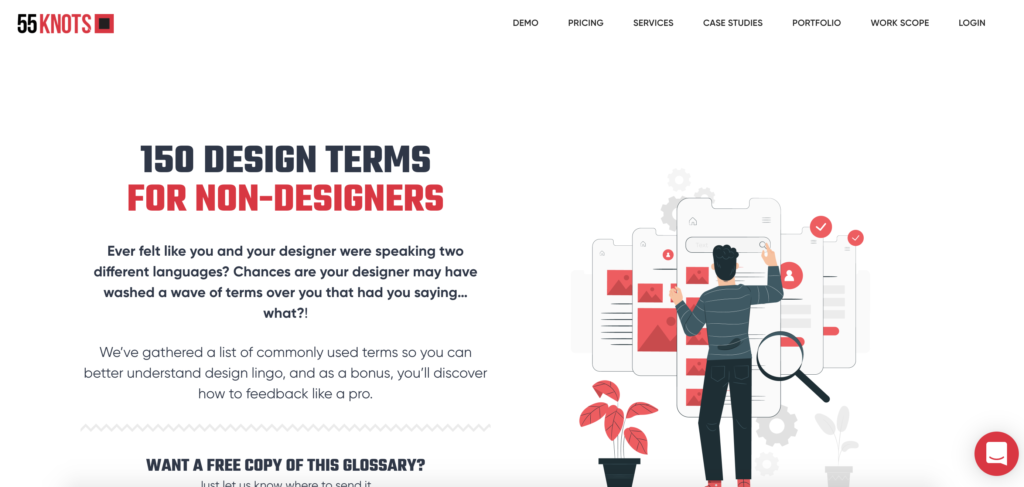
Pro tip: You can also use your resources for your marketing
activities!
2. Create a help
centre
Another thing you can do is create a help centre (most
live chat apps, and ManyRequests integrates with them, allow you to create
one).
The goal of the help centre is to get customers to help answer themselves any
questions they may have.
Here’s an example from DesignPickle’s help centre:
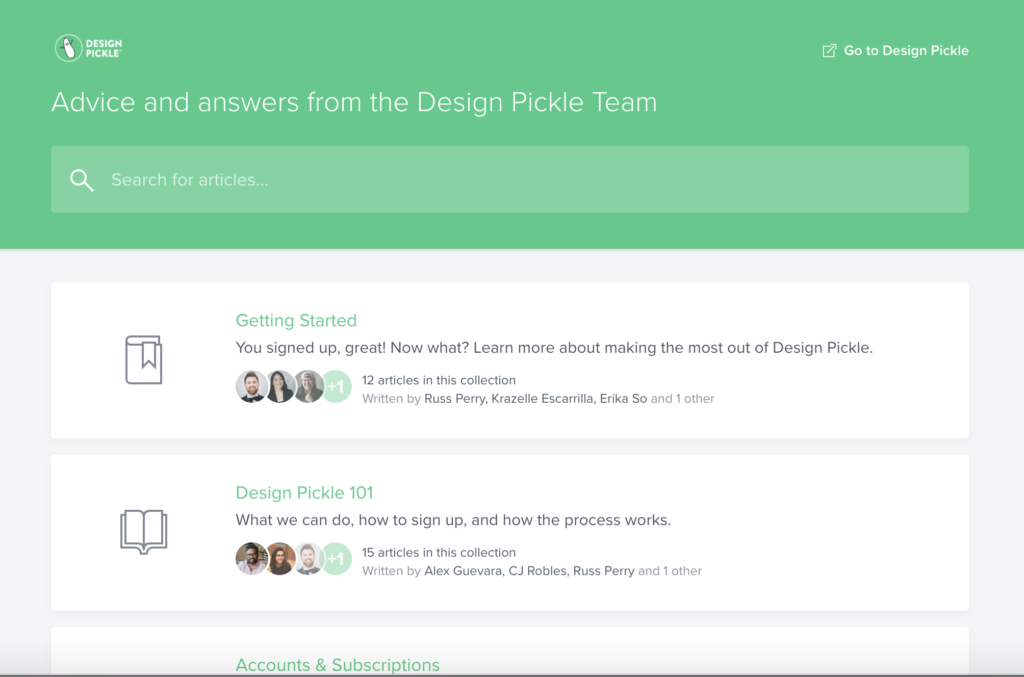
3. Send regular updates to your customers via email
Regularly communicating with your customers (for example, by sending a monthly update) is another great way to keep
them in the loop of what your company is doing and how it can benefit them.
Here’s an example from Superside, a design service for enterprise:
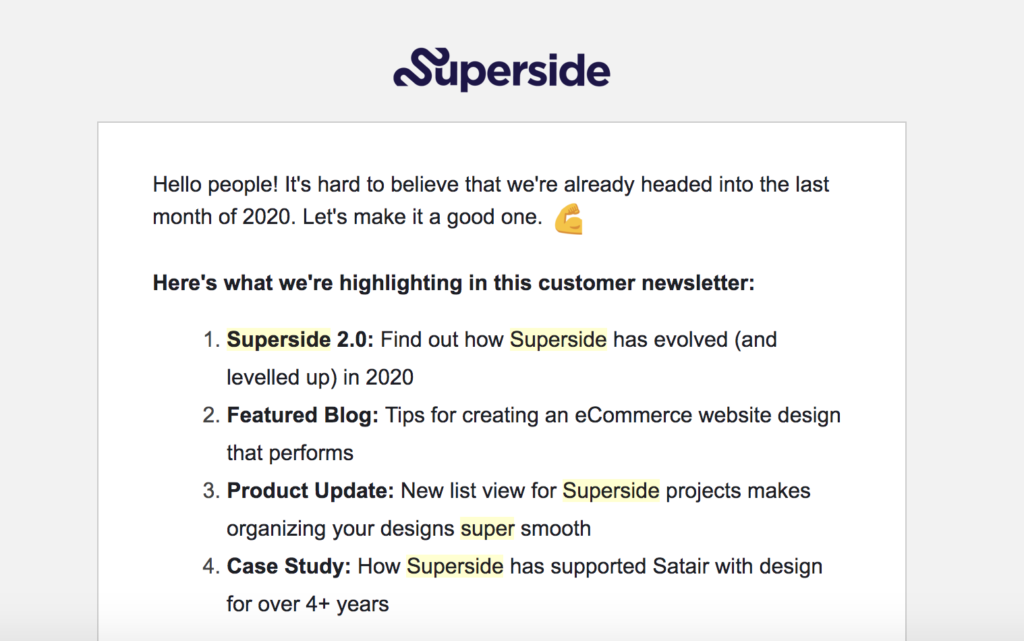
How to automate client communication at your agency
Now that you have an idea of what you can do to manage client communication at your agency and which processes and systems you can put in place, the next step is to automate as much of it as possible.
In this guide we’ll explore ways to automate client communication at your agency so that you can have:
- A more organized approach to communicating with your clients (no more lost files or threads)
- One place to handle all client communication related to your service requests (vs. on different channels)
- A scalable way to collaborate with your clients on requests and projects (adding due dates, comments, sharing
files)
Here’s what you can automate:
1. Intake forms
The first thing that clients need to give you: Their project details.
ManyRequests allows you to create customizable service intake forms so
that you can get all the information you need from your customers (including files too)
Here’s an example of
an intake form from 55Knots:

Pro tip: You can also add billing in your intake forms with ManyRequest, we integrate directly with
Stripe
2. Automated billing
Another nightmare of many agency owners:
Chasing invoices.
With ManyRequests you can manage all your billing from end-to-end such
as:
- Create one-off or recurring invoices (and request the payment via email or send a payment link)
-
Bill customers automatically
- Let your customers manage their subscriptions via their client
portal
3. Project communication
You’ve been there before:
The client communicates with you everywhere: Via email,
Facebook, send files everywhere.
Having a client portal to communicate with your clients is key to handling
communication properly.
With a client portal you can:
- Customize it (including your
logo, own domain name)
- Get customers to upload their files and access project deliverables at anytime
- Get
one place for customers to submit new tickets / service requests / projects
- Within projects / requests, keep
customers updated in real time of the project progress (with due dates), project progress (with custom status)
Key takeaways
Here are the key takeaways of a successful client communication for your agency:
- Great communication is about expectations (both from customers and your team)
- Onboarding is key to get customers to be successful with your service
- Internal communication and SOPs play a huge part to ensure a consistent service and to keep your team accountable.
- Customer success will help your customers get more value out of your service.
- Automation will help your communication to be organized.
If you have any questions do not hesitate to reach out and feel free to
start your free trial if you’re looking for a complete
end-to-end solution to manage client communication at your agency.
Running an agency?
ManyRequests is an all-in-one client portal and client requests management software.
Learn more